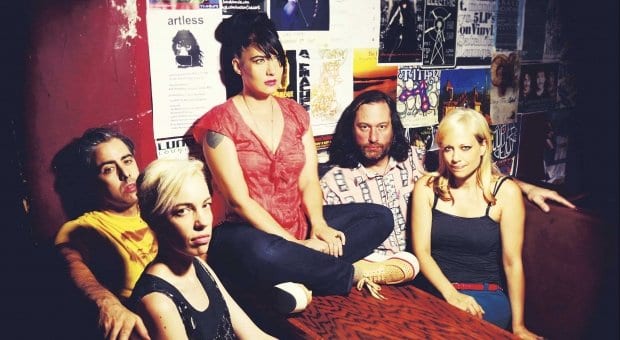How do you assemble your dream band? If you are Kathleen Hanna, the answer is somewhat stealthily.
In 2010, the ex-Bikini Kill singer and riot grrrl icon returned to music after a seven-year hiatus with The Julie Ruin, a five-piece band that grew out of her 1997 Julie Ruin bedroom project that was one of the first punk albums to dabble in electronics.
Run Fast (TJR/Dischord), the band’s debut, adds a contemporary pop polish to the raw punk minimalism of that earlier work. Whereas Bikini Kill and her dance-punk trio Le Tigre birthed and solidified Hanna’s image as an unflinching feminist punk leader, this project is her outlet for personal reflections on love, aging and mortality delivered through high-energy shouts, danceable bass lines and punchy guitar riffs.
To make it, she recruited a mix of self-taught and classically trained musicians, all of whom are in their 40s and have histories that combine music and activism.
“Kathleen basically collected the team like Charlie’s Angels,” explains keyboardist Kenny Mellman, who joined the band after collaborating with Hanna on a country song. At the time, Hanna was trying her hand at pop songwriting for other artists as a way to continue making music while privately dealing with Lyme disease, a debilitating infection that forced her to stop performing. (Director Sini Anderson chronicled Hanna’s illness for the forthcoming documentary The Punk Singer.)
Mellman is a pianist who spent two decades touring as one half of the cabaret drag duo Kiki and Herb.
“We wrote a song together, and then a couple of days later she called and said, ‘My manager says we’ll never break into the Nashville songwriting scene,’ so would you like to be in my band instead? Of course I said yes,” he says. “I think it was a ruse to see if we could work well together because we knew each other and she had performed once with my old act.”
Hanna also approached surf guitarist Sara Landau, who studied at Juilliard, runs a music school in New York City and coaches at a rock camp for girls in Brooklyn; drummer Carmine Covelli, an actor and punk rocker who worked as Le Tigre’s visual and lighting tech and on the band’s tour documentary Who Took the Bomp?; and bassist Kathi Wilcox, who played in Bikini Kill.
Wilcox received a similarly unexpected invite. In 2010, Hanna learned that her former bandmate was moving from DC to Brooklyn, so she invited her to attend the premiere of The Runaways biopic in New York. As they were navigating the red carpet to the cinema doors, Hanna suddenly turned and nervously blurted out, “Do you think you’d want to be in a band with me again?”
“I was like, ‘Uhhh? Yeah? I mean, Yeah!’” Wilcox recalls, laughing. “It was this mystery band, like ‘Do you want to join this project that you don’t know anything about?’ I was like, ‘I would love to be in a band with you, Kathleen.’ So then she sent me some songs, and I was like ‘Oh totally, this band is great. I would totally love to be in this band.’”
There is a greater emphasis on musicianship in The Julie Ruin than in Bikini Kill, a band that purposefully valued energy over virtuosity as a way to encourage young women to start their own bands.
Run Fast retains that brash punk energy, but the emotional palette is varied, the instrumentation more ambitious. In addition to playing bass, Wilcox sang backup for the first time and taught herself to play upright bass while recording “Just My Kind,” a flirty ballad inspired by Hanna’s husband, Beastie Boy Adam “Ad-Rock” Horovitz.
“Even in Bikini Kill, I don’t feel like all our songs had to sound like super-fast, three-chord punk songs,” Wilcox says. “On the last record, we were experimenting with prettier songs, you could say. Kathleen and I have continued to evolve, and we appreciate different things. We were not just strictly whatever people thought we were — a hardcore punk band.”
Defying long-standing preconceptions was another source of discussion in the studio. Although Hanna is the chief songwriter and lyricist, the album was written collaboratively. As such, Mellman wanted its sound to nod to the past while remaining current. For example, if Landau played a surf-guitar riff, he suggested pairing it with a deeper groove. “Selfishly, I wanted Kathleen’s new music to be new and not have people write it off as ‘Oh, this is just her screaming about feminism again’ — or however people discounted Le Tigre,” Mellman says.
“She is one of the most generous people to collaborate with because she understands the power that comes with giving up a little bit of yourself,” he says, explaining he never thought he would share singing duties — a development that might rankle the hardcore element in Hanna’s feminist fans.
“I was a little scared that people were gonna be like, ‘Ugh! There are male voices on this album!’” he says. “Luckily, there only seems to be two or three Twitter people who have that opinion.”
As Hanna’s return to music reignites conversations about feminism and the riot-grrrl movement’s legacy, Run Fast is a reminder that personal can be political and — as on all good pop albums — universal.
“It’s feminist to make a record about stuff that you care about,” Wilcox says. “It doesn’t all have to be songs about feminism. Making a record about things you care about, your health or your feelings is powerful in and of itself.”

 Why you can trust Xtra
Why you can trust Xtra


